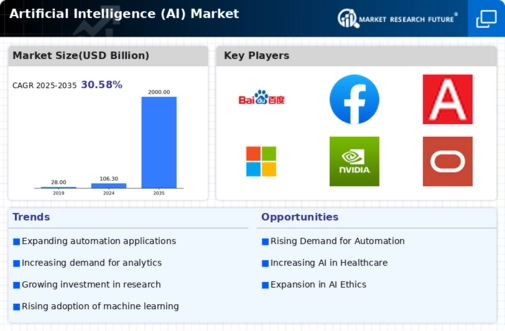Machine Learning
Natural Language Processing
Computer Vision
Robotics
Expert Systems
Healthcare
Finance
Retail
Automotive
Manufacturing
Cloud
On-Premises
Hybrid
Small and Medium Enterprises
Large Enterprises
North America
Europe
South America
Asia Pacific
Middle East and Africa
North America Outlook (USD Billion, 2019-2035)
North America Artificial Intelligence (AI) Market by Technology Type
Machine Learning
Natural Language Processing
Computer Vision
Robotics
Expert Systems
North America Artificial Intelligence (AI) Market by Application Type
Healthcare
Finance
Retail
Automotive
Manufacturing
North America Artificial Intelligence (AI) Market by Deployment Model Type
Cloud
On-Premises
Hybrid
North America Artificial Intelligence (AI) Market by End Use Type
Small and Medium Enterprises
Large Enterprises
North America Artificial Intelligence (AI) Market by Regional Type
US
Canada
US Outlook (USD Billion, 2019-2035)
US Artificial Intelligence (AI) Market by Technology Type
Machine Learning
Natural Language Processing
Computer Vision
Robotics
Expert Systems
US Artificial Intelligence (AI) Market by Application Type
Healthcare
Finance
Retail
Automotive
Manufacturing
US Artificial Intelligence (AI) Market by Deployment Model Type
Cloud
On-Premises
Hybrid
US Artificial Intelligence (AI) Market by End Use Type
Small and Medium Enterprises
Large Enterprises
CANADA Outlook (USD Billion, 2019-2035)
CANADA Artificial Intelligence (AI) Market by Technology Type
Machine Learning
Natural Language Processing
Computer Vision
Robotics
Expert Systems
CANADA Artificial Intelligence (AI) Market by Application Type
Healthcare
Finance
Retail
Automotive
Manufacturing
CANADA Artificial Intelligence (AI) Market by Deployment Model Type
Cloud
On-Premises
Hybrid
CANADA Artificial Intelligence (AI) Market by End Use Type
Small and Medium Enterprises
Large Enterprises
Europe Outlook (USD Billion, 2019-2035)
Europe Artificial Intelligence (AI) Market by Technology Type
Machine Learning
Natural Language Processing
Computer Vision
Robotics
Expert Systems
Europe Artificial Intelligence (AI) Market by Application Type
Healthcare
Finance
Retail
Automotive
Manufacturing
Europe Artificial Intelligence (AI) Market by Deployment Model Type
Cloud
On-Premises
Hybrid
Europe Artificial Intelligence (AI) Market by End Use Type
Small and Medium Enterprises
Large Enterprises
Europe Artificial Intelligence (AI) Market by Regional Type
Germany
UK
France
Russia
Italy
Spain
Rest of Europe
GERMANY Outlook (USD Billion, 2019-2035)
GERMANY Artificial Intelligence (AI) Market by Technology Type
Machine Learning
Natural Language Processing
Computer Vision
Robotics
Expert Systems
GERMANY Artificial Intelligence (AI) Market by Application Type
Healthcare
Finance
Retail
Automotive
Manufacturing
GERMANY Artificial Intelligence (AI) Market by Deployment Model Type
Cloud
On-Premises
Hybrid
GERMANY Artificial Intelligence (AI) Market by End Use Type
Small and Medium Enterprises
Large Enterprises
UK Outlook (USD Billion, 2019-2035)
UK Artificial Intelligence (AI) Market by Technology Type
Machine Learning
Natural Language Processing
Computer Vision
Robotics
Expert Systems
UK Artificial Intelligence (AI) Market by Application Type
Healthcare
Finance
Retail
Automotive
Manufacturing
UK Artificial Intelligence (AI) Market by Deployment Model Type
Cloud
On-Premises
Hybrid
UK Artificial Intelligence (AI) Market by End Use Type
Small and Medium Enterprises
Large Enterprises
FRANCE Outlook (USD Billion, 2019-2035)
FRANCE Artificial Intelligence (AI) Market by Technology Type
Machine Learning
Natural Language Processing
Computer Vision
Robotics
Expert Systems
FRANCE Artificial Intelligence (AI) Market by Application Type
Healthcare
Finance
Retail
Automotive
Manufacturing
FRANCE Artificial Intelligence (AI) Market by Deployment Model Type
Cloud
On-Premises
Hybrid
FRANCE Artificial Intelligence (AI) Market by End Use Type
Small and Medium Enterprises
Large Enterprises
RUSSIA Outlook (USD Billion, 2019-2035)
RUSSIA Artificial Intelligence (AI) Market by Technology Type
Machine Learning
Natural Language Processing
Computer Vision
Robotics
Expert Systems
RUSSIA Artificial Intelligence (AI) Market by Application Type
Healthcare
Finance
Retail
Automotive
Manufacturing
RUSSIA Artificial Intelligence (AI) Market by Deployment Model Type
Cloud
On-Premises
Hybrid
RUSSIA Artificial Intelligence (AI) Market by End Use Type
Small and Medium Enterprises
Large Enterprises
ITALY Outlook (USD Billion, 2019-2035)
ITALY Artificial Intelligence (AI) Market by Technology Type
Machine Learning
Natural Language Processing
Computer Vision
Robotics
Expert Systems
ITALY Artificial Intelligence (AI) Market by Application Type
Healthcare
Finance
Retail
Automotive
Manufacturing
ITALY Artificial Intelligence (AI) Market by Deployment Model Type
Cloud
On-Premises
Hybrid
ITALY Artificial Intelligence (AI) Market by End Use Type
Small and Medium Enterprises
Large Enterprises
SPAIN Outlook (USD Billion, 2019-2035)
SPAIN Artificial Intelligence (AI) Market by Technology Type
Machine Learning
Natural Language Processing
Computer Vision
Robotics
Expert Systems
SPAIN Artificial Intelligence (AI) Market by Application Type
Healthcare
Finance
Retail
Automotive
Manufacturing
SPAIN Artificial Intelligence (AI) Market by Deployment Model Type
Cloud
On-Premises
Hybrid
SPAIN Artificial Intelligence (AI) Market by End Use Type
Small and Medium Enterprises
Large Enterprises
REST OF EUROPE Outlook (USD Billion, 2019-2035)
REST OF EUROPE Artificial Intelligence (AI) Market by Technology Type
Machine Learning
Natural Language Processing
Computer Vision
Robotics
Expert Systems
REST OF EUROPE Artificial Intelligence (AI) Market by Application Type
Healthcare
Finance
Retail
Automotive
Manufacturing
REST OF EUROPE Artificial Intelligence (AI) Market by Deployment Model Type
Cloud
On-Premises
Hybrid
REST OF EUROPE Artificial Intelligence (AI) Market by End Use Type
Small and Medium Enterprises
Large Enterprises
APAC Outlook (USD Billion, 2019-2035)
APAC Artificial Intelligence (AI) Market by Technology Type
Machine Learning
Natural Language Processing
Computer Vision
Robotics
Expert Systems
APAC Artificial Intelligence (AI) Market by Application Type
Healthcare
Finance
Retail
Automotive
Manufacturing
APAC Artificial Intelligence (AI) Market by Deployment Model Type
Cloud
On-Premises
Hybrid
APAC Artificial Intelligence (AI) Market by End Use Type
Small and Medium Enterprises
Large Enterprises
APAC Artificial Intelligence (AI) Market by Regional Type
China
India
Japan
South Korea
Malaysia
Thailand
Indonesia
Rest of APAC
CHINA Outlook (USD Billion, 2019-2035)
CHINA Artificial Intelligence (AI) Market by Technology Type
Machine Learning
Natural Language Processing
Computer Vision
Robotics
Expert Systems
CHINA Artificial Intelligence (AI) Market by Application Type
Healthcare
Finance
Retail
Automotive
Manufacturing
CHINA Artificial Intelligence (AI) Market by Deployment Model Type
Cloud
On-Premises
Hybrid
CHINA Artificial Intelligence (AI) Market by End Use Type
Small and Medium Enterprises
Large Enterprises
INDIA Outlook (USD Billion, 2019-2035)
INDIA Artificial Intelligence (AI) Market by Technology Type
Machine Learning
Natural Language Processing
Computer Vision
Robotics
Expert Systems
INDIA Artificial Intelligence (AI) Market by Application Type
Healthcare
Finance
Retail
Automotive
Manufacturing
INDIA Artificial Intelligence (AI) Market by Deployment Model Type
Cloud
On-Premises
Hybrid
INDIA Artificial Intelligence (AI) Market by End Use Type
Small and Medium Enterprises
Large Enterprises
JAPAN Outlook (USD Billion, 2019-2035)
JAPAN Artificial Intelligence (AI) Market by Technology Type
Machine Learning
Natural Language Processing
Computer Vision
Robotics
Expert Systems
JAPAN Artificial Intelligence (AI) Market by Application Type
Healthcare
Finance
Retail
Automotive
Manufacturing
JAPAN Artificial Intelligence (AI) Market by Deployment Model Type
Cloud
On-Premises
Hybrid
JAPAN Artificial Intelligence (AI) Market by End Use Type
Small and Medium Enterprises
Large Enterprises
SOUTH KOREA Outlook (USD Billion, 2019-2035)
SOUTH KOREA Artificial Intelligence (AI) Market by Technology Type
Machine Learning
Natural Language Processing
Computer Vision
Robotics
Expert Systems
SOUTH KOREA Artificial Intelligence (AI) Market by Application Type
Healthcare
Finance
Retail
Automotive
Manufacturing
SOUTH KOREA Artificial Intelligence (AI) Market by Deployment Model Type
Cloud
On-Premises
Hybrid
SOUTH KOREA Artificial Intelligence (AI) Market by End Use Type
Small and Medium Enterprises
Large Enterprises
MALAYSIA Outlook (USD Billion, 2019-2035)
MALAYSIA Artificial Intelligence (AI) Market by Technology Type
Machine Learning
Natural Language Processing
Computer Vision
Robotics
Expert Systems
MALAYSIA Artificial Intelligence (AI) Market by Application Type
Healthcare
Finance
Retail
Automotive
Manufacturing
MALAYSIA Artificial Intelligence (AI) Market by Deployment Model Type
Cloud
On-Premises
Hybrid
MALAYSIA Artificial Intelligence (AI) Market by End Use Type
Small and Medium Enterprises
Large Enterprises
THAILAND Outlook (USD Billion, 2019-2035)
THAILAND Artificial Intelligence (AI) Market by Technology Type
Machine Learning
Natural Language Processing
Computer Vision
Robotics
Expert Systems
THAILAND Artificial Intelligence (AI) Market by Application Type
Healthcare
Finance
Retail
Automotive
Manufacturing
THAILAND Artificial Intelligence (AI) Market by Deployment Model Type
Cloud
On-Premises
Hybrid
THAILAND Artificial Intelligence (AI) Market by End Use Type
Small and Medium Enterprises
Large Enterprises
INDONESIA Outlook (USD Billion, 2019-2035)
INDONESIA Artificial Intelligence (AI) Market by Technology Type
Machine Learning
Natural Language Processing
Computer Vision
Robotics
Expert Systems
INDONESIA Artificial Intelligence (AI) Market by Application Type
Healthcare
Finance
Retail
Automotive
Manufacturing
INDONESIA Artificial Intelligence (AI) Market by Deployment Model Type
Cloud
On-Premises
Hybrid
INDONESIA Artificial Intelligence (AI) Market by End Use Type
Small and Medium Enterprises
Large Enterprises
REST OF APAC Outlook (USD Billion, 2019-2035)
REST OF APAC Artificial Intelligence (AI) Market by Technology Type
Machine Learning
Natural Language Processing
Computer Vision
Robotics
Expert Systems
REST OF APAC Artificial Intelligence (AI) Market by Application Type
Healthcare
Finance
Retail
Automotive
Manufacturing
REST OF APAC Artificial Intelligence (AI) Market by Deployment Model Type
Cloud
On-Premises
Hybrid
REST OF APAC Artificial Intelligence (AI) Market by End Use Type
Small and Medium Enterprises
Large Enterprises
South America Outlook (USD Billion, 2019-2035)
South America Artificial Intelligence (AI) Market by Technology Type
Machine Learning
Natural Language Processing
Computer Vision
Robotics
Expert Systems
South America Artificial Intelligence (AI) Market by Application Type
Healthcare
Finance
Retail
Automotive
Manufacturing
South America Artificial Intelligence (AI) Market by Deployment Model Type
Cloud
On-Premises
Hybrid
South America Artificial Intelligence (AI) Market by End Use Type
Small and Medium Enterprises
Large Enterprises
South America Artificial Intelligence (AI) Market by Regional Type
Brazil
Mexico
Argentina
Rest of South America
BRAZIL Outlook (USD Billion, 2019-2035)
BRAZIL Artificial Intelligence (AI) Market by Technology Type
Machine Learning
Natural Language Processing
Computer Vision
Robotics
Expert Systems
BRAZIL Artificial Intelligence (AI) Market by Application Type
Healthcare
Finance
Retail
Automotive
Manufacturing
BRAZIL Artificial Intelligence (AI) Market by Deployment Model Type
Cloud
On-Premises
Hybrid
BRAZIL Artificial Intelligence (AI) Market by End Use Type
Small and Medium Enterprises
Large Enterprises
MEXICO Outlook (USD Billion, 2019-2035)
MEXICO Artificial Intelligence (AI) Market by Technology Type
Machine Learning
Natural Language Processing
Computer Vision
Robotics
Expert Systems
MEXICO Artificial Intelligence (AI) Market by Application Type
Healthcare
Finance
Retail
Automotive
Manufacturing
MEXICO Artificial Intelligence (AI) Market by Deployment Model Type
Cloud
On-Premises
Hybrid
MEXICO Artificial Intelligence (AI) Market by End Use Type
Small and Medium Enterprises
Large Enterprises
ARGENTINA Outlook (USD Billion, 2019-2035)
ARGENTINA Artificial Intelligence (AI) Market by Technology Type
Machine Learning
Natural Language Processing
Computer Vision
Robotics
Expert Systems
ARGENTINA Artificial Intelligence (AI) Market by Application Type
Healthcare
Finance
Retail
Automotive
Manufacturing
ARGENTINA Artificial Intelligence (AI) Market by Deployment Model Type
Cloud
On-Premises
Hybrid
ARGENTINA Artificial Intelligence (AI) Market by End Use Type
Small and Medium Enterprises
Large Enterprises
REST OF SOUTH AMERICA Outlook (USD Billion, 2019-2035)
REST OF SOUTH AMERICA Artificial Intelligence (AI) Market by Technology Type
Machine Learning
Natural Language Processing
Computer Vision
Robotics
Expert Systems
REST OF SOUTH AMERICA Artificial Intelligence (AI) Market by Application Type
Healthcare
Finance
Retail
Automotive
Manufacturing
REST OF SOUTH AMERICA Artificial Intelligence (AI) Market by Deployment Model Type
Cloud
On-Premises
Hybrid
REST OF SOUTH AMERICA Artificial Intelligence (AI) Market by End Use Type
Small and Medium Enterprises
Large Enterprises
MEA Outlook (USD Billion, 2019-2035)
MEA Artificial Intelligence (AI) Market by Technology Type
Machine Learning
Natural Language Processing
Computer Vision
Robotics
Expert Systems
MEA Artificial Intelligence (AI) Market by Application Type
Healthcare
Finance
Retail
Automotive
Manufacturing
MEA Artificial Intelligence (AI) Market by Deployment Model Type
Cloud
On-Premises
Hybrid
MEA Artificial Intelligence (AI) Market by End Use Type
Small and Medium Enterprises
Large Enterprises
MEA Artificial Intelligence (AI) Market by Regional Type
GCC Countries
South Africa
Rest of MEA
GCC COUNTRIES Outlook (USD Billion, 2019-2035)
GCC COUNTRIES Artificial Intelligence (AI) Market by Technology Type
Machine Learning
Natural Language Processing
Computer Vision
Robotics
Expert Systems
GCC COUNTRIES Artificial Intelligence (AI) Market by Application Type
Healthcare
Finance
Retail
Automotive
Manufacturing
GCC COUNTRIES Artificial Intelligence (AI) Market by Deployment Model Type
Cloud
On-Premises
Hybrid
GCC COUNTRIES Artificial Intelligence (AI) Market by End Use Type
Small and Medium Enterprises
Large Enterprises
SOUTH AFRICA Outlook (USD Billion, 2019-2035)
SOUTH AFRICA Artificial Intelligence (AI) Market by Technology Type
Machine Learning
Natural Language Processing
Computer Vision
Robotics
Expert Systems
SOUTH AFRICA Artificial Intelligence (AI) Market by Application Type
Healthcare
Finance
Retail
Automotive
Manufacturing
SOUTH AFRICA Artificial Intelligence (AI) Market by Deployment Model Type
Cloud
On-Premises
Hybrid
SOUTH AFRICA Artificial Intelligence (AI) Market by End Use Type
Small and Medium Enterprises
Large Enterprises
REST OF MEA Outlook (USD Billion, 2019-2035)
REST OF MEA Artificial Intelligence (AI) Market by Technology Type
Machine Learning
Natural Language Processing
Computer Vision
Robotics
Expert Systems
REST OF MEA Artificial Intelligence (AI) Market by Application Type
Healthcare
Finance
Retail
Automotive
Manufacturing
REST OF MEA Artificial Intelligence (AI) Market by Deployment Model Type
Cloud
On-Premises
Hybrid
REST OF MEA Artificial Intelligence (AI) Market by End Use Type
Small and Medium Enterprises
Large Enterprises

















Leave a Comment